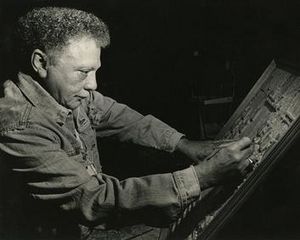Archie Byron facts for kids
Quick facts for kids
Archie Byron
|
|
|---|---|

Archie Byron in his studio in Atlanta, Georgia
|
|
| Born | 1928 |
| Died | 2005 (aged 76–77) |
| Nationality | American |
| Known for | Relief sculptures |
| Movement | Modern Art |
Archie Byron (1928-2005) was a talented American artist, a smart business owner, and even a city councilman in Atlanta, Georgia. He was also a political activist who cared deeply about his community. Byron is most famous for his unique sculptures made from sawdust, water, and glue. He called this special way of making art "sawdust art." Sometimes he painted these sculptures, and other times he let the natural wood colors show.
Contents
The Early Life of Archie Byron
Archie Byron was born on February 2, 1928, in Atlanta, Georgia. His father was a musician, and his mother was a seamstress. Archie was named after his grandmother, who was part English and part Native American. He was mostly raised by this grandmother.
Archie and his eight brothers and sisters went to Catholic school in downtown Atlanta. They also attended catechism classes on weekends.
Friendship with Martin Luther King Jr.
Archie's father played music at the same church that Martin Luther King Jr.'s family attended. Archie and Martin Luther King Jr. were friends when they were kids. After Dr. King was assassinated, Archie's security company helped protect the King family. Even though they were close, Archie and his family did not join Dr. King's marches. This was because Dr. King believed in peaceful protests without weapons. Archie once said he would only march if he could carry his shotgun.
Military Service and Family Life
Archie Byron joined the U.S. Navy and served during the end of World War II. He saw fighting in Okinawa. After the war, he returned to Atlanta in 1949. He used a program called the G.I. Bill to go to technical college. There, he learned about architectural drafting (drawing building plans) and bricklaying.
He married a woman named Joyce, and they had four children together. For 16 years, Archie supported his family by working as a brick mason and in construction.
A Career in Law Enforcement and Politics
Archie was always interested in law enforcement. As a child, he wanted to be a police officer. However, police forces in Atlanta were segregated at the time. This meant black officers could not arrest white citizens.
In 1961, Archie partnered with two other black men and the Fulton County Police Department. Together, they created what they believed was America's first detective agency owned by African Americans. Four years later, Archie started his own detective agency. He also opened other businesses, including a gun repair shop and a security guard training school.
From 1981 to 1989, Archie Byron served on the Atlanta city council for District 10. This meant he helped make important decisions for the city.
Archie Byron passed away on August 29, 2005, at the age of 85.
Archie Byron's Art Career
Archie Byron said his wife, Joyce, first inspired him to make art. In 1975, while working security, he found a tree root that looked like a gun. He brought it home, and Joyce told him to create something from it. He carved the wood into a gun shape. This was the start of his art career, which he called "tree-limb art." Like other artists, he found hidden shapes in wood and brought them to life through carving and painting.
The Birth of "Sawdust Art"
In 1977, Archie found another artistic idea while working in his gun repair shop. He had piles of sawdust and wondered if he could use it. After trying different things, he mixed sawdust with water and white glue. This made a strong, thick material he could sculpt.
Archie called this new art "sawdust art." He explained that it was a messy process. He had to add layers of the mixture one after another. It took a long time to finish a piece, but the material was very strong. One art collector even said it could last for over 400 years!
What Archie Byron's Art Shows
Archie Byron's art covered many different topics. He created strange landscapes, unique figures, religious symbols, and images of historical figures and everyday people. His most famous works are his "Anatomy" series. In these pieces, he took apart and put back together male and female forms. This showed his creative and modern way of making art. His art often reflected the social issues he cared about as a city councilman.
Exhibitions
- Living Traditions: Southern Black Folk Art. 17 Aug.- 27 Oct. 1991, The Museum of York County, Rock Hill South Carolina.
- Passionate Visions of the American South. 1993-5, New Orleans Museum of Art, New Orleans, LA.
- Southern Folk Art from the Permanent Collection. 28 Apr.- 22 Jul. 2012, Georgia Museum of Art at the University of Georgia, Atlanta.
- Testimony: Vernacular Art of the African-American South. Jul. 2003-2004.
- Bearing Witness: African-American Art of the South. 1997, Schaumburg Center for Research on Black Culture, New York City.
- Revelations: Art from the African American South. 3 Jun 2017- 1 Apr. 2018, Fine Arts Museum of San Francisco, San Francisco, CA.
Permanent Collections
Archie Byron's artwork can be found in the permanent collections of these museums:
- Smithsonian American Art Museum
- Fine Arts Museums of San Francisco
- Minneapolis Institute of Art
- High Museum of Art
- Museum of Fine Arts, Houston
- Modern Primitive

